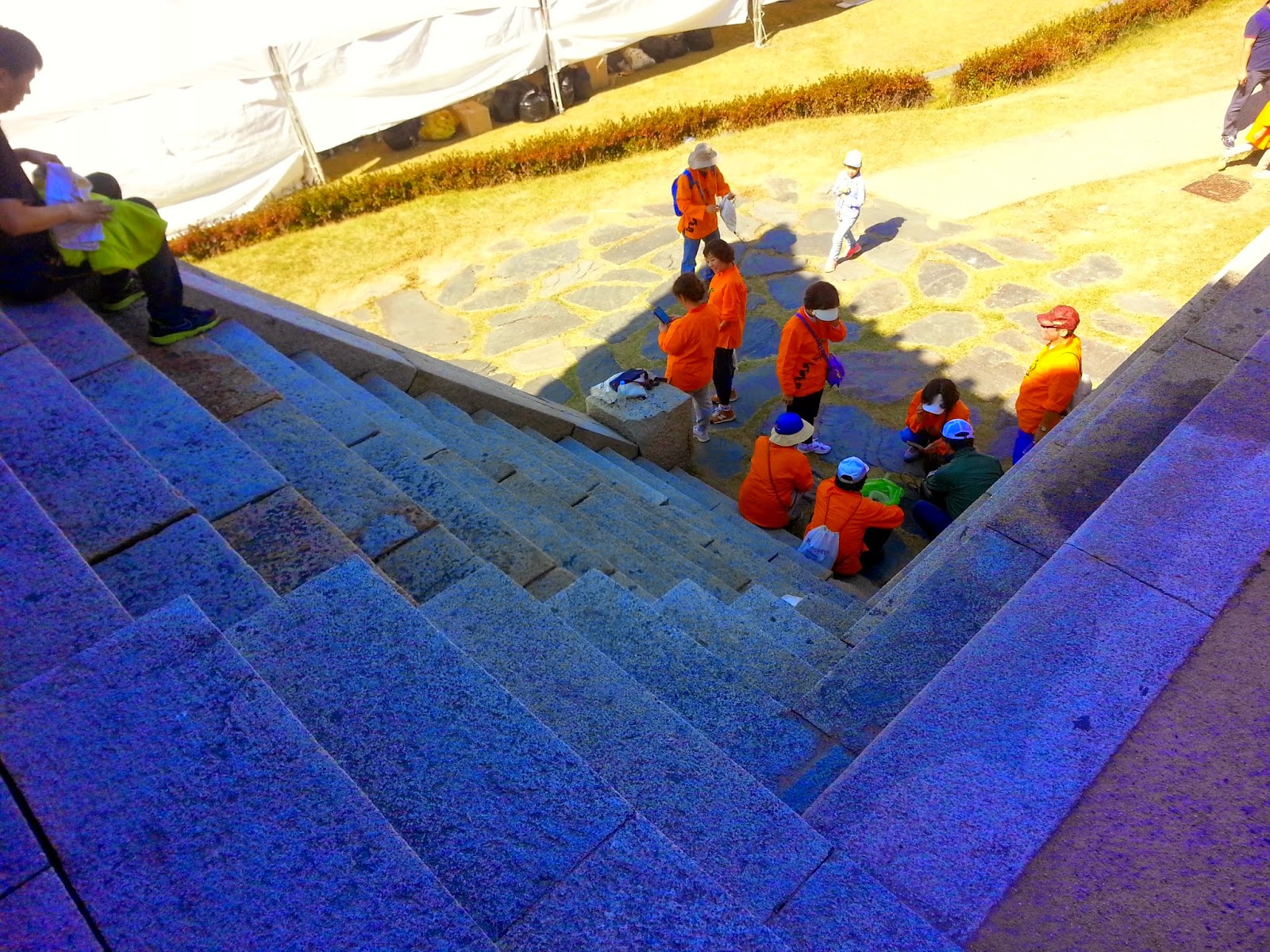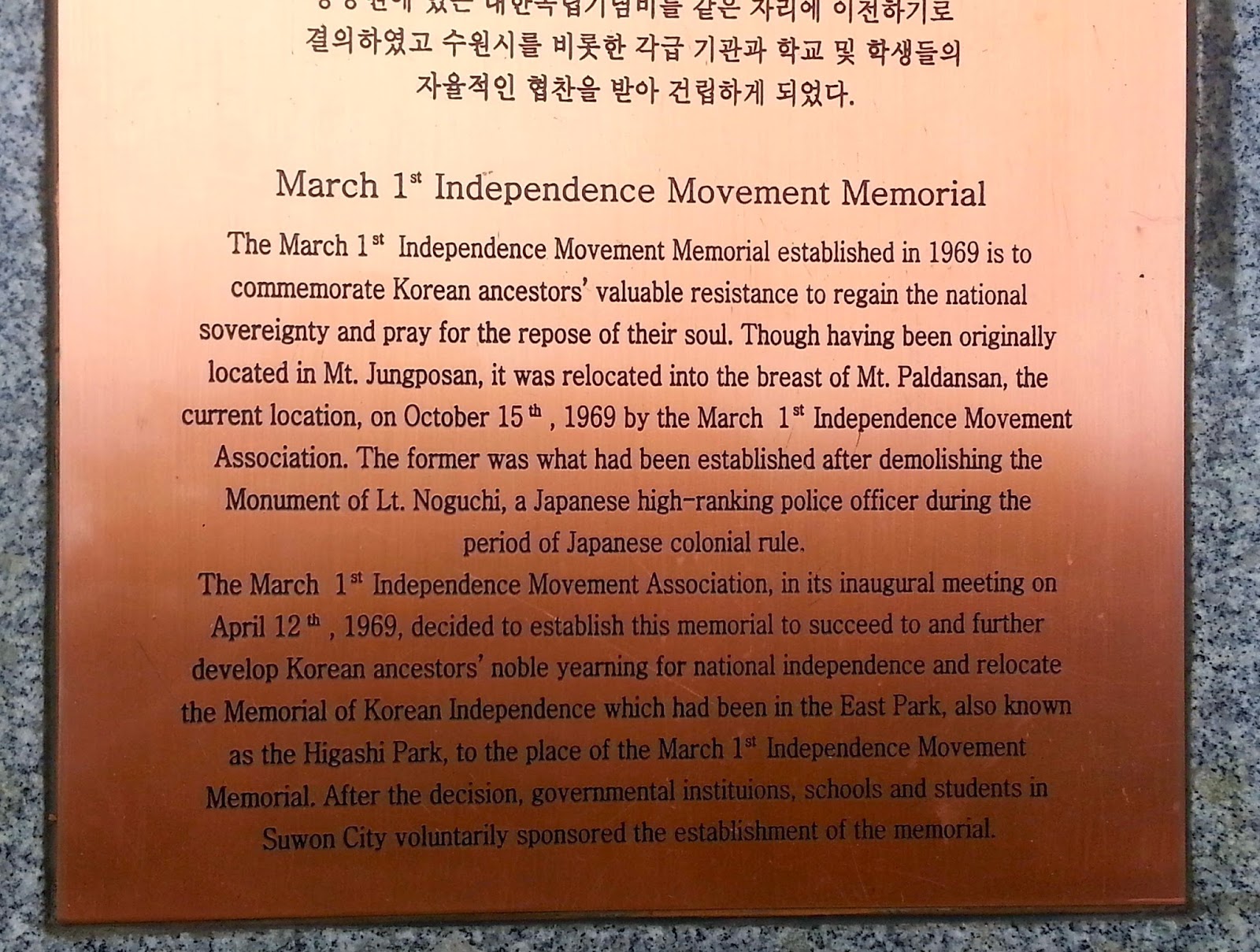Well, it took awhile to get this post going, since I had soooo many pictures to go through from the day, but here it finally is for your reading pleasure. We took a family trip south on a beautiful, sunny Sunday to Suwon for a hike around the Hwaseong Fortress. It was an easy ride on Subway Line 1 from our local stop and then we boarded a nearby bus at Suwon Station, headed toward the Paldalmun gate.
As we hopped off, we already knew this was going to be a great day, as the first of the four main gates - Paldalmun - was beautiful.
We turned down the street to the right of the gate, walked through a bustling market space, and found our starting point.
A little background from the site's brochure:
Suwon Hwaseong Fortress, Historic Sites No. 3, was built over two years and nine months, from January 1794 to September 1796, by King Jeongjo, the 22nd king of the Joseon Dynasty, to move the tomb of his father, Crown Prince Jangjeon, also known as Crown Prince Sado, because of his filial duty to his father. (While searching online, it seems CP Sado was killed by his own father. Sado was accused of killing and abusing people at the palace, so it is said his father locked him in a rice trunk, where he then died.)
The wall is approximately 5.7 kilometers long and was designed by Silhak scholars. It is known as a unique structure in the history of architecture because of its use of stones and bricks together in a modern fortress structure to deflect arrows, spears, swords, guns, and cannons. Restoratation and repair of the fortress began in 1975 and it was registered as a UNESCO World Heritage Site in 1997.
Yes, we hiked the entire perimeter, from #1 to #43!
The first section, called Namsumun, crosses over the stream which flows through the center of the fortress. We explored the nooks and crannies along the wall, imagining what they might have been used for (other than hid an seek with a 4 year old).

At the top of the first climb was a structure named Dongnamgangnu. I managed to snap a picture of most of the accompanying signs for the wall sections, so I will let you read those for more detail along this virtual journey (remember to click on the picture if you want to see a larger version of it).
There were flags all along the fortress - this first section (East side) had red ones.
Some areas had structures and others were simply open spaces.
I love the colors used in the decorative areas on all of the Korean palaces and similar sites. It is known as Dancheong and there are five basic colors; blue-green (east), white (west), red (south), black (north), and yellow (center).
There was a play area for Michael to take a walking break, so we ha our first "rest stop".
The Beacon Tower was built in 1796 as an integral part of the architecture, not as an independent tower on top of a mountain, as is typically seen in Korean fortresses.
As we moved along, the flag color changed from red to blue, and we came across our first open door.
Onward we went, along the wall, taking in all of the neighboring homes, churches, and recreational areas.

We reached the second main gate - Changnyongmun - and carefully navigated our way through the middle and away form the steep stairs.
The section was a rounded corner, with decorative areas and a field nearby for events and archery.
This led us to Dongjangdae, one of two command posts on the wall. It was used for martial arts training and overseeing the interior of the fortress form the East
I could not resist snapping this next picture...as I must have missed the memo about hiking a 5K fortress wall in heels. Silly me, with my sensible sneakers!
This area had an information center, snack shop, archery opportunity, and traditional Korean bow and arrow exhibit.
At this point, we had thought we would grab a ticket for the Dragon Trolley and enjoy a leisurely ride along the northern end of the wall (and give Michael a walking break), but the tickets were sold out until 3 hours later, so we had a quick lunch and pressed on.
The biggest reason we had hoped for the trolley was that this next section is all uphill towards the highest point. This began the true "hike" but was beautiful.
We stopped for a quick selfie, with our new selfie stick, by the DongbukGaknu pavilion and garden.
Next up was the Buksumun flood gate, the stream, and giant lanterns along its route.
And we pressed onward...
...towards the 3rd main gate, Janganmun.
But first, we had a small detour for bingsu (ice cream) and water at Pasiya - a quick stop just down the hill from the main path.
We found a pretty cool canon at the next turret.
And Rob had a moment of pretend...
We walked along the outer wall of Janganmun, which had an interesting view.
Photo-op: Michael now says, "Kim-cheese!" :)
The last main gate - Hwaseomun - on the northwest corner of the fortress wall.
This gate had a nicer view outside its border.
Then the real climb began. We got mixed in with a group of hikers in orange, who were supporting a charity or cause.
The last part of the climb was steep. I didn't get a picture, as I was way behind him at that point, but Rob was a super Dad - he carried the backpack AND Michael (who finally had enough) up the last set of steps.
The view was totally worth it.
The traditional buildings in the bottom of this next picture are the Hwaseong Haenggung - the palace inside the fortress. We did not even make it to this on our visit, so we will have to come back again.
At the summit of Paldal Mountain, we found SeoJangdae - the second command post of the fortress.
This area also had a great opportunity to ring an enormous bell for 1,000-2,000 won. We took full advantage and Michael loved it!
There were also two modern monuments on the top of the mountain, dedicated to aspects of Korean Independence.
Our final structure, before we began the great descent, was SeonamAmmun - one of the secret gates which was designed for war supply storage and could be easily filled in with rocks for protection.
Then we began the trek downward.
It was a lot of steps down. :)

We made it! We ended back at the first gate (Paldalmun), hailed a taxi, headed to Suwon Station (after a little translation help from my phone for "train station"), and splurged on comfy, direct trip tickets on the Korail train.
For those living in or visiting Korean - this is a great day trip - we highly recommend you go!
Ticket information
























































































